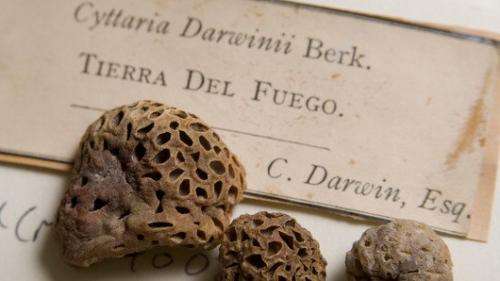Revolutionising the Fungarium - a genomic treasure trove?

A DNA sequencing breakthrough has used samples from Kew's Fungarium to show that genetic information can be accessed from even very old samples, holding out the promise of significant discoveries which may have profound impacts on all our lives.
Kew's fungi collection
Kew holds one of the oldest, largest, and most important reference collections of dried fungi in the world. We estimate there are 1.25 million specimens in our collection. Many of these are historically significant, with specimens that date back to the 1780s, including specimens collected by Charles Darwin during his voyage on HMS Beagle.
These specimens are an essential record of the occurrence of fungi in space and time but, with a shift in emphasis in science over the past few decades to molecular data, their utility for modern research has waned. Many of these old specimens are nearly decayed and most of them have DNA that have been broken into small pieces and modified through chemical reactions and now retain little of their original features. Although it has been technically possible to decode "ancient" DNA from very old organisms (Neanderthals and wooly mammoths come to mind), these have all been painstakingly tedious, time-consuming, and expensive affairs. Thus, the poor preservation of DNA in museum specimens is largely seen as an insurmountable obstacle to harvesting genetic information from them in an efficient and cost-effective way. So have all of these specimens lost their value for modern science?
A DNA sequencing breakthrough...
A recent study in eLife has demonstrated that by applying new DNA sequencing technology, whole genomes can be determined efficiently from very old specimens. The researchers used historical specimens of Phytophthora infestans held in our Fungarium that date back to 1845 and, with modern DNA-repairing enzymes and new sequencing technologies that rapidly yield millions of short DNA sequences, were able to assemble its genome by comparing it with a reference.
The authors concluded from these genome sequences that the historical fungus that caused the major blights of potato in the 19th century, leading to the infamous Irish Potato Famine, is a distinct lineage that is now extinct. While this is a fascinating discovery, the real epiphany may be the proof-of-concept that whole genomes can be successfully determined from these crusty old specimens. The implication for our collections is enormous: we potentially are sitting on a genomic treasure trove. Unknown information lies locked away in these dried fungi that may have profound impacts on all our lives, just as the discoveries of powerful medicines like penicillin and cyclosporine have done before.
... will revolutionise the importance of the collection
The average fungal genome is 37 Mb—or 37 million bases—in length. Quite small in comparison to most plants and animals. Yet, that is precisely why fungi have become a model for genome sequencing. The first eukaryote to have its genome sequenced was Brewers' Yeast (Saccharomyces cerevisiae) and today the most ambitious genome project aims to produce 1,000 fungal genomes within the next several years. But these are just scratching the surface of this remarkable and mega-diverse Kingdom—which probably includes more than 1.5 million species. And now that it has become technically feasible to access this information from Fungarium specimens, we may be on the verge of a major collections-based revolution—our Fungarium alone may contain more than 50 million Mb (50 million million!) of genomic data.
The enormous breadth and depth of specimens held within the world's fungaria offer an unparalleled opportunity to capture colossal amounts of genome data from a huge diversity of species - a task that would take many lifetimes to complete if we could only rely on fresh samples for genome sequencing. Technological advances are making it possible to change the game and breathe new life into museum collections, revealing their enduring relevance to modern science and their potential for enhancing society... Now all we need is the funding to make it happen.
More information: eLife article: The rise and fall of the Phytophthora infestans lineage that triggered the Irish potato famine: elife.elifesciences.org/conten … /2/e00731/abstract-1
Journal information: eLife
Provided by Royal Botanic Gardens, Kew


















